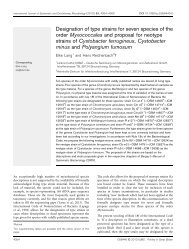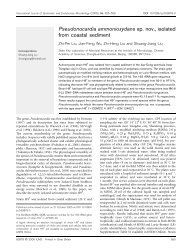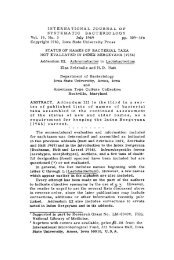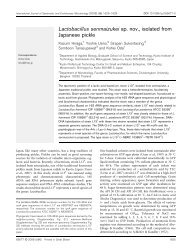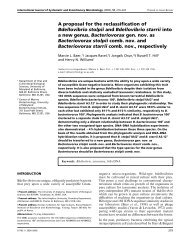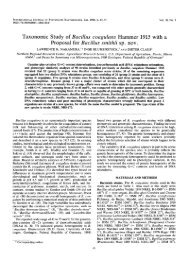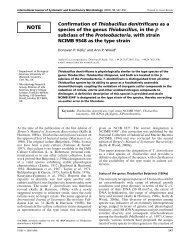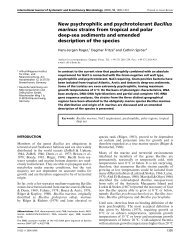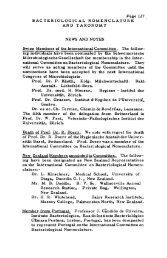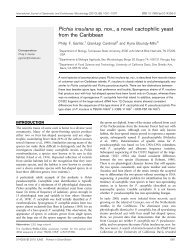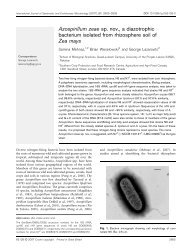Curvibasidium cygneicollum gen. nov., sp. nov. and Curvibasidium ...
Curvibasidium cygneicollum gen. nov., sp. nov. and Curvibasidium ...
Curvibasidium cygneicollum gen. nov., sp. nov. and Curvibasidium ...
You also want an ePaper? Increase the reach of your titles
YUMPU automatically turns print PDFs into web optimized ePapers that Google loves.
J. P. Sampaio <strong>and</strong> others<br />
Dimorphic. Hyphae (1?5–2?5 mm in diameter) are formed<br />
after mating of sexually compatible strains. Two mating<br />
types are known (see Table 1). Clamp connections are<br />
present <strong>and</strong> medallion-shaped (Fig. 2c). Colacosomes are<br />
absent. Telio<strong>sp</strong>ores are usually <strong>sp</strong>herical (10–19 mm in<br />
diameter), sometimes ovoid or pear-shaped (9–166<br />
10–21 mm), terminal or intercalary (Fig. 2d). Basidia are<br />
one-celled [3?5–5 (6?5)630–50 (70) mm], curved <strong>and</strong><br />
produced after a prolonged resting stage of the telio<strong>sp</strong>ores<br />
(Fig. 2d). Sessile, bacilliform basidio<strong>sp</strong>ores [2?5–3?566–15<br />
(19) mm] are produced on short basidial appendages that<br />
originate on the convex side of the basidium (Fig. 2d). Each<br />
basidium has one to four sites of basidio<strong>sp</strong>ore formation<br />
<strong>and</strong> multiple basidio<strong>sp</strong>ores are formed at each site.<br />
Basidio<strong>sp</strong>ores germinate by budding. Yeast cells are long<br />
<strong>and</strong> ovoid to cylindrical (2–565–11 mm) (Fig. 2c). Streak<br />
cultures are pale orange to pinkish-cream, flat, smooth,<br />
butyrous, semi-dull or glistening. Colony margins are entire.<br />
Physiological <strong>and</strong> biochemical features of C. pallidicorallinum<br />
are available at http://www.crem.fct.unl.pt/dimorphic_<br />
basidiomycetes/Databases/databases.htm <strong>and</strong> tests that allow<br />
its differentiation from C. <strong>cygneicollum</strong> <strong>and</strong> R. nothofagi<br />
are depicted in Table 2. The phylo<strong>gen</strong>etic placement of<br />
C. pallidicorallinum is shown in Fig. 1. C. pallidicorallinum<br />
is sensitive to the mycocins produced by R. glutinis <strong>and</strong><br />
R. mucilaginosa, but insensitive to mycocins secreted by<br />
R. pallida <strong>and</strong> by <strong>sp</strong>ecies of the <strong>gen</strong>era Cryptococcus,<br />
Cystofilobasidium, Filobasidium <strong>and</strong> Sporidiobolus.<br />
Microscopic slides from the crossing of VKM Y-2284 T <strong>and</strong><br />
VKM Y-2861, including mycelium, telio<strong>sp</strong>ores, basidia <strong>and</strong><br />
basidio<strong>sp</strong>ores, were deposited in the Portuguese Yeast<br />
Culture Collection under number ZP-02-03 (holotype). As<br />
the physiological <strong>and</strong> molecular characterization of a mixed<br />
culture presents obvious difficulties, we propose that strain<br />
VKM Y-2284 T , isolated from a gramineous plant collected<br />
in the Moscow region, Russia, should be designated the<br />
type strain of C. pallidicorallinum. This strain is deposited<br />
in the Russia Collection of Microorganisms (VKM),<br />
Institute for Biochemistry <strong>and</strong> Physiology of Microorganisms,<br />
Russian Academy of Sciences, Pushchino, Russia. Two<br />
strains have also been deposited in the Centraalbureau voor<br />
Schimmelcultures (CBS), Yeast Division, Utrecht, The<br />
Netherl<strong>and</strong>s: CBS 9091 T (=VKM Y-2284 T ) <strong>and</strong> CBS 9642<br />
(=VKM Y-2861).<br />
The life cycles of C. <strong>cygneicollum</strong> <strong>and</strong> C. pallidicorallinum<br />
were investigated on MYP agar, CMA <strong>and</strong> PDA.<br />
Conjugation of opposite mating types resulted in the<br />
formation of true mycelium with clamp connections. In<br />
C. pallidicorallinum, clamp connections have a peculiar<br />
medallion shape (Fig. 2c). For both <strong>sp</strong>ecies, telio<strong>sp</strong>ores are<br />
abundant 1 week after inoculation, but their germination<br />
requires a prolonged resting stage. For C. <strong>cygneicollum</strong>,<br />
crossings made on PDA plates <strong>and</strong> incubated for 2 weeks at<br />
room temperature were sealed <strong>and</strong> maintained at 15 uC<br />
for 9 months. After that period, small agar blocks containing<br />
telio<strong>sp</strong>ores were transferred to 2 % water agar <strong>and</strong><br />
incubated at room temperature. Telio<strong>sp</strong>ores germinated<br />
approximately 1 week after transfer to water agar. Although<br />
the same procedures were also successful for C. pallidicorallinum,<br />
the original observation of the complete life cycle of<br />
this <strong>sp</strong>ecies employed CMA. Agar pieces containing 1-<br />
month-old telio<strong>sp</strong>ores were soaked in distilled water <strong>and</strong><br />
maintained at 5 uC for 1 year. Telio<strong>sp</strong>ore germination<br />
occurred on transfer of the agar blocks to 2 % water agar <strong>and</strong><br />
incubation for 1 week at room temperature. The type strain<br />
of C. pallidicorallinum has mycocino<strong>gen</strong>ic activity (Golubev,<br />
1992). Its killing patterns are unique, as they include not<br />
only urediniomycetous yeasts (Rhodo<strong>sp</strong>oridium, Rhodotorula<br />
<strong>and</strong> Sporidiobolus), but also hymenomycetous yeasts<br />
(Cryptococcus, Cystofilobasidium, Filobasidium <strong>and</strong> Itersonilia).<br />
This is the first report of mycocins that are active against<br />
yeasts of two different classes.<br />
Phylo<strong>gen</strong>etic placement<br />
The phylo<strong>gen</strong>etic position of <strong>Curvibasidium</strong> was inferred<br />
by comparing the D1/D2 domains of the 26S rRNA <strong>gen</strong>e<br />
sequences of the two <strong>sp</strong>ecies with representative members<br />
of the Microbotryomycetidae (Fig. 1). C. <strong>cygneicollum</strong><br />
differed from C. pallidicorallinum by three substitutions.<br />
The sequences of the two <strong>sp</strong>ecies showed no intra<strong>sp</strong>ecific<br />
variability. The closest relative of <strong>Curvibasidium</strong> was<br />
Leuco<strong>sp</strong>oridium fasciculatum Bab’eva & Lisichkina, with<br />
19 mismatches with re<strong>sp</strong>ect to C. <strong>cygneicollum</strong> <strong>and</strong> 22<br />
mismatches with re<strong>sp</strong>ect to C. pallidicorallinum. The<br />
association of L. fasciculatum with <strong>Curvibasidium</strong> received<br />
strong statistical support (Fig. 1). As L. fasciculatum is not<br />
related to Leuco<strong>sp</strong>oridium scottii Fell, Statzell, Hunter &<br />
Phaff, this <strong>sp</strong>ecies was excluded from the circumscription of<br />
the order Leuco<strong>sp</strong>oridiales (Sampaio et al., 2003). We reexamined<br />
the micromorphological features of L. fasciculatum<br />
(Fig. 2e, f) <strong>and</strong> confirmed the observations made by<br />
Bab’eva & Lisichkina (2000). The mycelium of L. fasciculatum,<br />
in contrast to that of <strong>Curvibasidium</strong>, lacks clamp<br />
connections (Fig. 2e) <strong>and</strong> the basidia are septate (phragmobasidia)<br />
(Fig. 2f). As the holobasidium of <strong>Curvibasidium</strong><br />
is a unique trait in the Microbotryomycetidae, this feature<br />
is an important diagnostic property for the new <strong>gen</strong>us<br />
<strong>and</strong> is probably a derived characteristic. The absence of<br />
this characteristic in L. fasciculatum prevented us from<br />
transferring this <strong>sp</strong>ecies to <strong>Curvibasidium</strong>. Moreover,<br />
<strong>Curvibasidium</strong> has CoQ 9 (Goto & Oguri, 1983), which is<br />
an uncommon feature in the Microbotryomycetidae.<br />
However, this chemotaxonomic marker has not yet been<br />
determined for L. fasciculatum. From nutritional <strong>and</strong><br />
physiological per<strong>sp</strong>ectives, L. fasciculatum is also wellseparated<br />
from <strong>Curvibasidium</strong> (Table 2). We consider<br />
that a study of additional teleomorphic <strong>sp</strong>ecies related to<br />
<strong>Curvibasidium</strong> <strong>and</strong> L. fasciculatum is needed before a change<br />
in the scope of <strong>Curvibasidium</strong>, or the creation of a new <strong>gen</strong>us<br />
for L. fasciculatum, is made.<br />
Another important feature of <strong>Curvibasidium</strong> is the absence<br />
of colacosomes (also referred to as lenticular bodies).<br />
Among members of the Microbotryomycetidae that are<br />
1406 International Journal of Systematic <strong>and</strong> Evolutionary Microbiology 54



